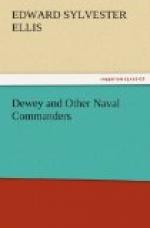Enough has been related concerning Stephen Decatur to show that he was the most prominent of our naval leaders in our last war with Great Britain. He entered into the work with the same dauntless enthusiasm he showed whenever it was his privilege to serve his country, and his capture of the Macedonian was one of the most brilliant exploits of the many that took place during those memorable years.
In order to understand my use of the words “captain” and “commodore,” it is necessary to explain that at the time to which I now refer the latter rank was different from what it is to-day. The commodore of a squadron was the highest ranking officer and he might be lower than a captain. Thus “Commodore” Perry, who won the remarkable victory on Lake Erie, was promoted from that rank to “captain.”
Another interesting fact may be named. The Stars and Stripes used in that war was slightly different in pattern from the present, for, instead of containing thirteen stripes, as it did at the close of the Revolution and as it does to-day, it had fifteen. The first law of Congress bearing on this point was to add a stripe for every new State admitted to the Union, but after two had come in and others were making ready it became evident that before long the pattern of the beautiful emblem would be spoiled if the rule were followed. So the increase in the number of stripes stopped and remained fifteen for a few years after the close of the war, even though new States had been admitted. Then the law was changed so as to provide that the increase of States should be shown by the stars in the blue field, while the stripes should always remain thirteen in number, typical of the original colonies of the Revolution.
It was decided early in the war to send a squadron consisting of the President, Captain Stephen Decatur, and the sloops of war Peacock, Captain Warrington, and Hornet, Lieutenant Biddle, and the storeship Tom Bowline on a cruise in the Indian Ocean. This squadron was to rendezvous at Tristan d’Acunha, but failed to do so, for a reason that has been stated in the account of the exploits of the Hornet and Peacock.
Captain Decatur lay in the harbor of New York with his vessels and found himself so closely blockaded by the British squadron that it was impossible for the Americans to sail in company. He sent out the two ships named, and, on the night of January 14, 1815, when the blockading squadron had been driven to the south by a gale, he sailed down the Narrows, hoping to get to sea before it returned. There was good reason to expect success, but misfortune speedily came. The beacon lights had been removed and early in the evening the pilot ran the ship aground just before reaching Sandy Hook. It required two hours of the hardest kind of work to get her off. The President was not very seaworthy at the start, and the efforts to reach deep water so injured her that it was necessary to return to the city for repairs, but the strong contrary wind prevented and she was driven over the bar.




